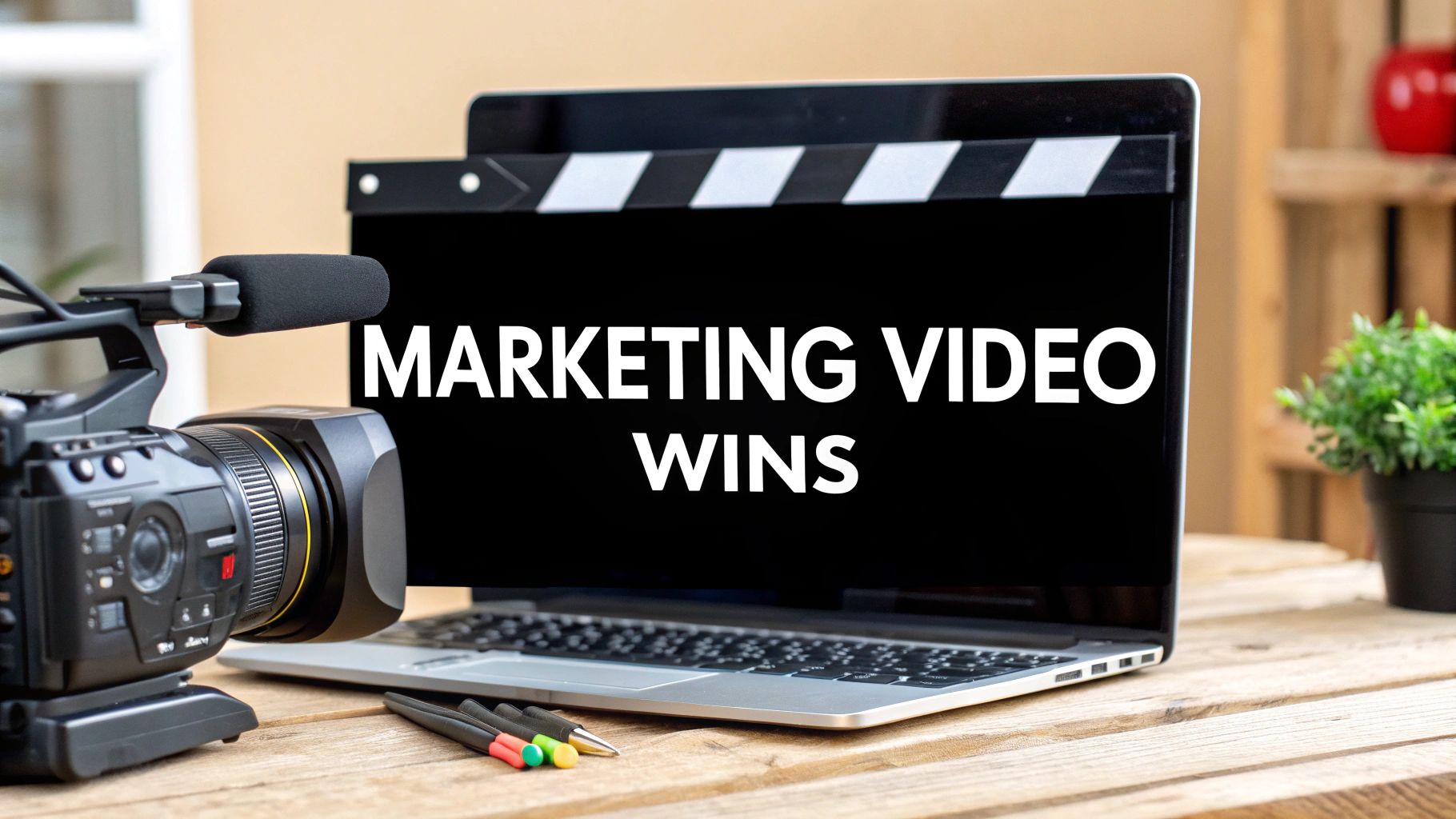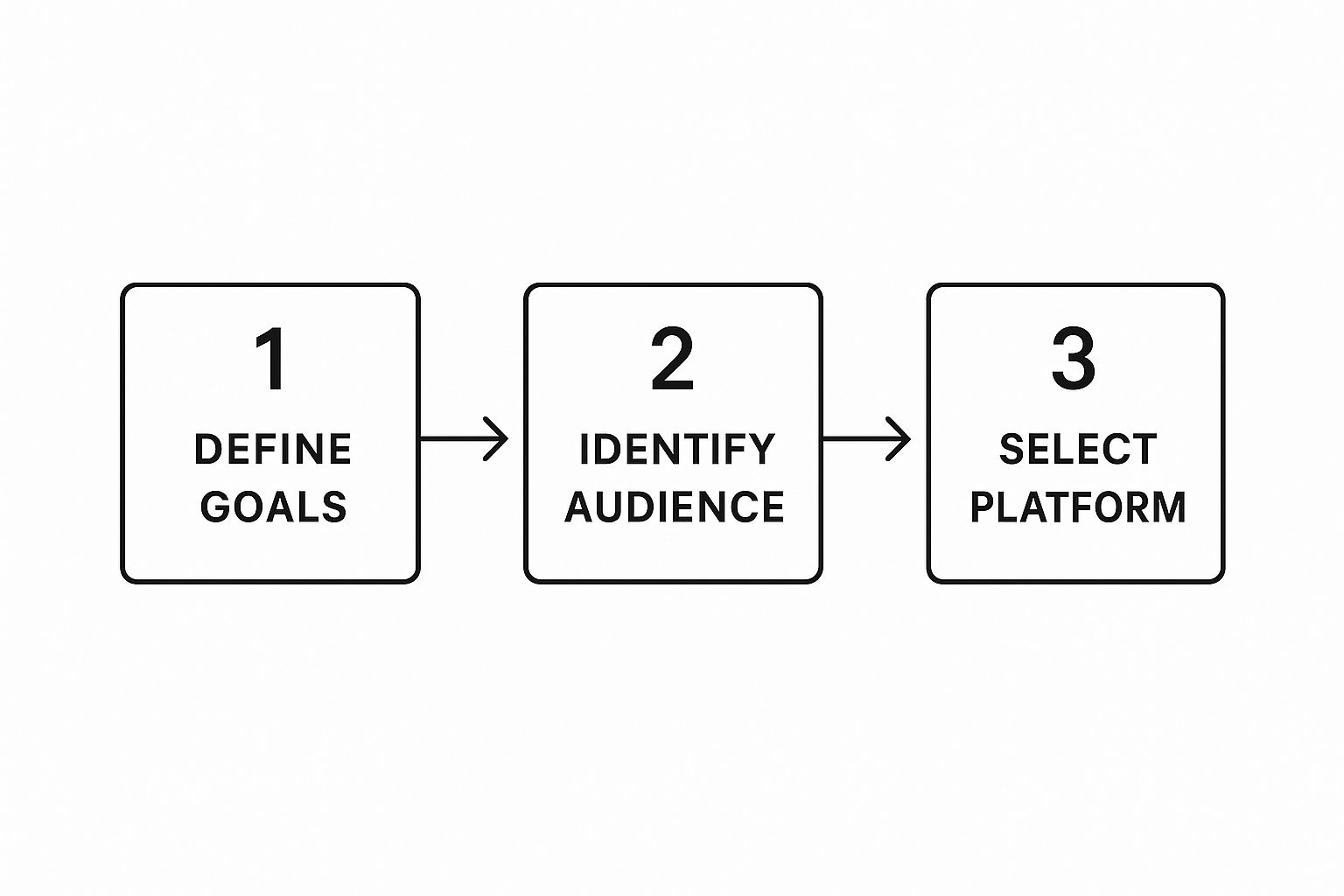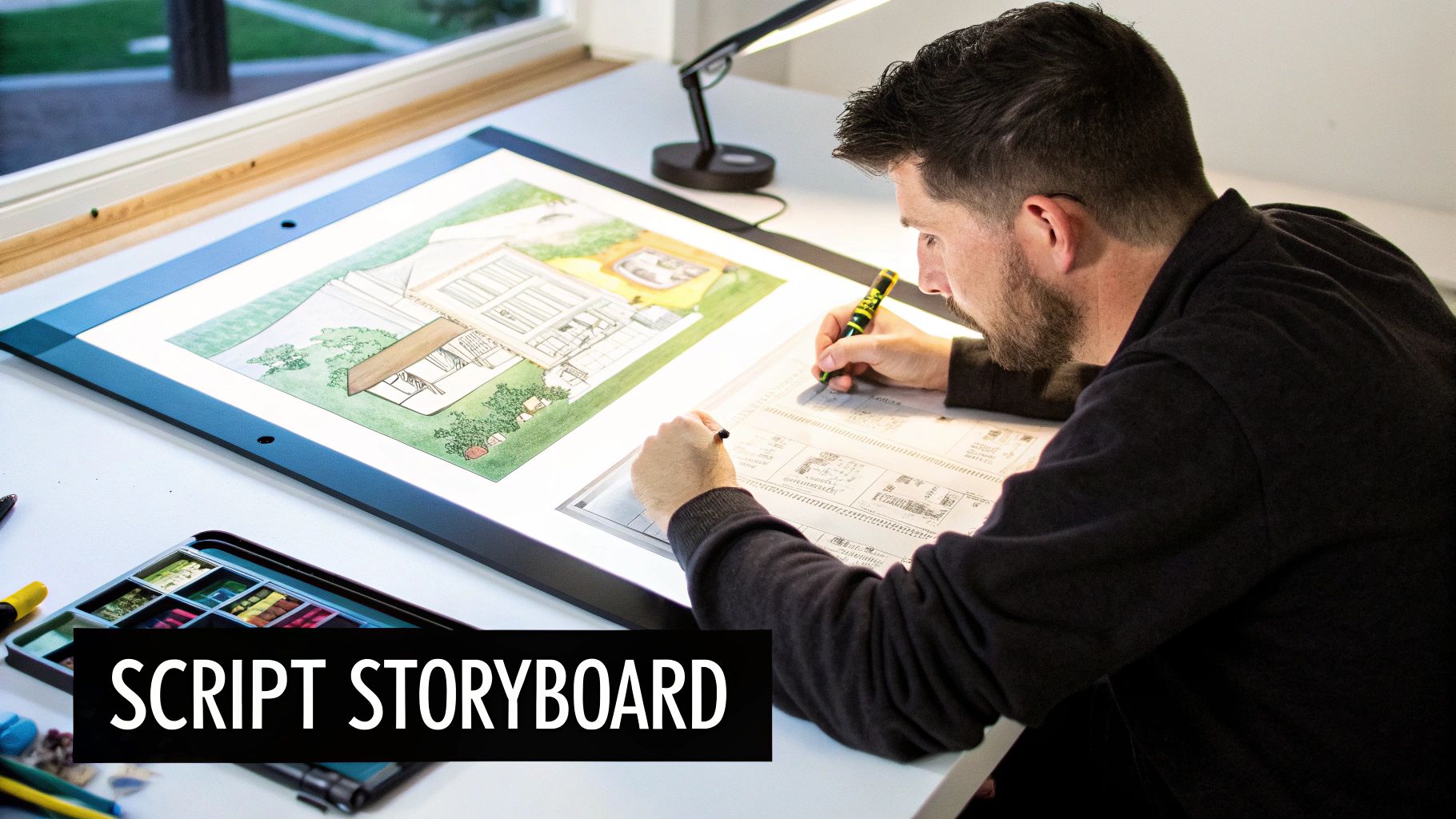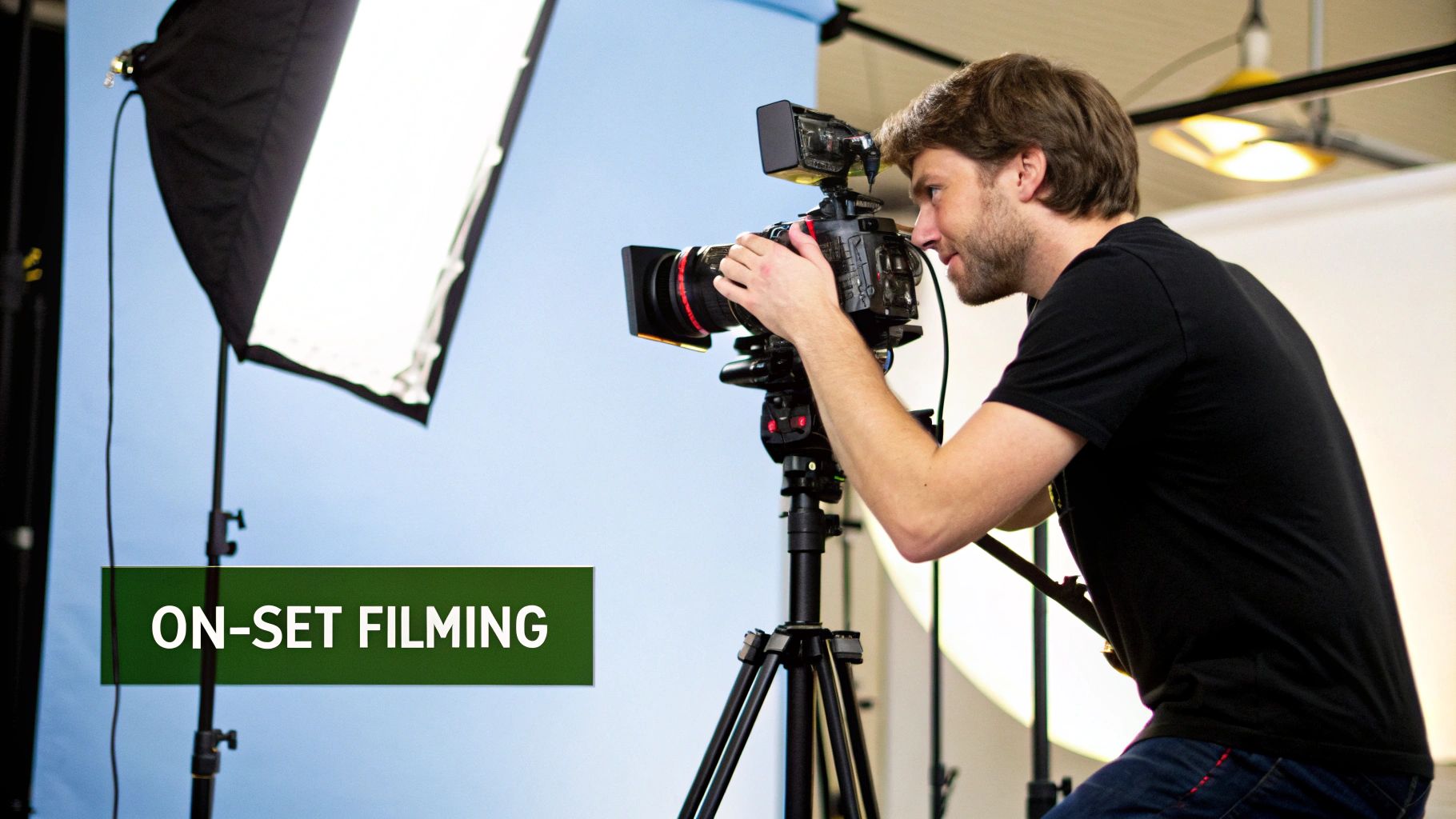
How to Create a Marketing Video That Wins
Learn how to create a marketing video that drives real results. Our guide covers strategy, scripting, production, and AI-powered editing for modern marketers.
Before you even think about hitting record, let's talk strategy.
This is where most marketing videos go wrong. People get excited about the creative part—the filming, the cool shots, the music—and they completely skip the foundational work. But a great video isn't born from a fancy camera; it's forged from a rock-solid plan built long before you ever press record.
Without a clear strategy, you're just making noise. This initial planning phase is all about being intentional. It's where you ask the tough questions that will guide every decision you make down the line, from scripting to distribution.
Nail Down Your Primary Video Goal
First things first: what are you actually trying to achieve? A video without a goal is like a ship without a rudder. Are you trying to get your name out there, pull in some new leads, or directly drive sales?
While a single video can do a few things at once, you’ll see much better results by focusing on one primary objective. Trying to be everything to everyone just creates a muddled message that doesn't resonate with anyone.
Pick one core purpose:
- Brand Awareness: Your main goal is simply to introduce your brand to a new audience. Here, you’ll be tracking metrics like views, impressions, and social shares.
- Lead Generation: You want to capture contact info from potential customers. Success is all about form submissions and click-through rates on your call-to-action.
- Sales Conversion: The finish line is a purchase. You’ll be watching direct sales, add-to-cart rates, and overall conversion rates like a hawk.
A focused goal does more than just sharpen your message. It makes measuring your ROI dead simple. You'll know exactly which key performance indicators (KPIs) to track to see if your video actually worked.
To help you connect your video's purpose with the right metrics, here’s a quick-reference table.
Matching Video Goals to Business KPIs
| Video Goal | Primary KPI to Track | Example Metric | | :--- | :--- | :--- | | Brand Awareness | Reach & Engagement | Video Views, Social Shares | | Lead Generation | Conversion Rate | Gated Content Downloads | | Customer Education | Watch Time | Average View Duration | | Sales Conversion | Revenue | Direct Sales Attributed to Video |
Using a table like this ensures you're not just guessing at your video's impact—you're measuring it with hard data.
This simple, three-step flow is visually laid out below.

As you can see, defining your goals and audience comes first—long before you ever worry about which platform to post on.
Figure Out Your Target Audience
Okay, you know your "why." Now for the "who." Who are you actually trying to reach with this video? Don't just stop at basic demographics like age and location. You need to get inside their heads and understand their motivations, their biggest headaches, and where they hang out online.
When you have a crystal-clear picture of your ideal viewer, your message will hit home on a much more personal level. It’s no surprise that 87% of marketers say video has directly helped them increase sales. That success comes from making a genuine connection with the right people.
To get this right, you need to build out detailed profiles of who you're talking to. For a deep dive, check out our guide on https://viewprinter.tech/blog/articles/how-to-create-buyer-personas. It’ll walk you through crafting a story that speaks directly to their world. If you want to learn more about the entire process from start to finish, this guide explains how to create interactive video effectively and keep viewers hooked.
Get Real About Your Budget and Timeline
Finally, let's bring this strategy back down to earth. A classic mistake is wildly underestimating the time and money a good video requires. Your budget is going to shape everything, from the gear you can afford to whether you hire professional actors or rope in your own team.
Fire up a simple spreadsheet and start listing out the potential costs:
- Equipment: Camera, lights, microphones.
- Talent: Any actors or influencers?
- Location: Studio rental or travel costs.
- Post-Production: Editing software, music licensing, stock clips.
- Distribution: Your ad spend budget.
At the same time, map out a clear timeline. Set real deadlines for pre-production (planning), production (filming), and post-production (editing). Having a schedule doesn't just keep you organized; it prevents small hiccups from turning into expensive delays. This groundwork is what sets your project up for success from day one.
Crafting a Story That Connects and Converts

Okay, you’ve got your strategy locked in. Now for the fun part: building the story. This is where you graduate from goals and metrics to create something that actually resonates with people on an emotional level. A great story is what makes the difference between a video that gets skipped and one that gets results.
The most powerful narrative structure I’ve seen is surprisingly simple, and it has nothing to do with making your brand the star of the show. You have to flip the script.
Your Customer Is the Hero
Every great story has a hero. In your marketing video, that hero absolutely has to be your customer. They’re the ones facing a real challenge, and your video needs to reflect their world, their frustrations, and what they’re trying to achieve. When viewers see themselves in the story, they’re hooked.
So, don't kick things off by listing your product's features. Start by acknowledging your hero’s problem. What's the conflict they're dealing with every day? Wasted time? Lost revenue? Some persistent, nagging annoyance? Get that front and center, fast.
Your product isn’t the hero—it's the wise guide. Think of it as the Yoda or the Dumbledore of the story. It's the tool or insight that gives the hero (your customer) the power to solve their problem and win the day.
This framework is so effective because it’s built on empathy and puts all the focus on the value your customer gets.
Writing a Script That Sounds Human
Once you know the story you’re telling, it's time to script it out. The biggest mistake I see marketers make here is writing dialogue that sounds like a corporate press release. Your goal is to write like people actually talk.
Here are a few practical tips to keep your script feeling real and engaging:
- Read It Out Loud. This is non-negotiable. If a line feels clunky when you say it, it's going to sound ten times worse on camera. This simple check is the best way to catch awkward phrasing and unnatural sentences.
- Keep the Language Simple. Ditch the jargon and overly complicated words. Your message needs to be crystal clear from the get-go. Imagine explaining your solution to a friend—that’s the tone you’re after.
- Focus on One Single Message. Your script should hammer home the one core goal you set earlier. Don't try to cram every single feature and benefit into a 60-second video. Stick to the main problem and your solution.
Key Takeaway: Your script is more than just words; it's the emotional blueprint for your viewer's journey. Keep it simple, focused, and human.
If you’re stuck on how to structure your narrative, checking out a well-written advertising script example can give you a solid framework for building a compelling story arc.
Storyboarding Your Vision (No Art Degree Required)
With a solid script ready, the last step before you start filming is the storyboard. I know this sounds intimidating, but you absolutely do not need to be an artist to pull this off. A storyboard is just a visual outline of your video, shot by shot.
Its whole purpose is to translate the words on the page into a concrete visual plan. This gets everyone—from the person holding the camera to the editor—on the same page. A simple storyboard can save you from hours of confusion and expensive reshoots later.
How to Create a Simple Storyboard
You can do this with a pen and paper, a whiteboard, or a basic digital template. For each key scene or line of dialogue, just create a quick panel that includes:
- A Rough Sketch: Seriously, stick figures are fine! Just draw a basic idea of what’s on screen. Is it a close-up of someone’s face? A wide shot of your product? A screen recording?
- Shot Description: Add a quick note about the camera angle (e.g., "medium shot," "over the shoulder") and any key action happening in the frame.
- Dialogue or Voiceover: Jot down the corresponding lines from your script that go with that visual.
This visual map forces you to think through the pacing, transitions, and the overall flow before you ever press record. It’s an essential step in turning a good script into a great video.
Time to Film: Your Guide to a Smooth and Professional Shoot

You’ve got a solid story and a visual plan. Now for the fun part: bringing your marketing video to life. Production day is where all that groundwork pays off, turning ideas into actual footage. This can feel like a lot of pressure, but with the right prep, it can be a smooth—and even enjoyable—process.
The secret isn't a Hollywood-level budget. It's about being smart with your gear, lighting, and sound to create a final product that looks and feels professional.
The Only Gear You Really Need
Let’s bust a myth right now: you don’t need a multi-thousand-dollar camera to make a great marketing video. The latest iPhone or Google Pixel shoots in crisp 4K resolution, which means the device already in your pocket is probably more than enough to get started.
Have a DSLR or mirrorless camera? Great. You’ll get more manual control over things like focus and depth of field. But honestly, the single most important piece of equipment isn't the camera—it's a tripod. Shaky, handheld footage screams "amateur." A simple, affordable tripod is the fastest way to get stable, professional-looking shots.
The Two Pillars of Pro-Quality Video
If you only have the budget to upgrade two things, make it your lighting and your audio. Nothing else will have a bigger impact on how professional your video feels. People might forgive slightly grainy footage, but they will click away from a video with bad sound in a heartbeat.
-
Lighting: You can skip the complex studio setup. A simple "three-point lighting" kit with a few affordable LED panels will make a world of difference. On a tight budget? Film near a large window on an overcast day. You'll get incredible, soft natural light for free. The goal is just to get rid of harsh shadows and make sure your subject is lit clearly and evenly.
-
Audio: Your camera or phone's built-in mic is designed to pick up sound from every direction—including that annoying air conditioner hum and street noise. An external mic is non-negotiable. A simple lavalier (lapel) mic that clips onto a shirt or a shotgun mic mounted on your camera will isolate the speaker's voice and give you crystal-clear audio. It’s a small investment that delivers a huge return.
Bad audio is the silent killer of good video. Crystal-clear sound builds trust and keeps your audience engaged, while poor audio makes your brand seem unprofessional and causes viewers to drop off immediately.
Setting Up Your Space for Success
Your filming location matters more than you think. Before you hit record, take a few minutes to prep the space. First, declutter the background. A messy office or a distracting poster can pull focus right where you don't want it. A clean, simple, on-brand background is always the best bet.
Next, shut down any potential interruptions. Put a sign on the door, silence your phones, and close the windows to block out street noise. Every minute you spend dealing with an interruption is a minute of wasted time.
Directing and Capturing Dynamic Shots
When it's go-time, your storyboard is your roadmap. It’ll guide you through exactly what shots you need, ensuring you don’t miss anything crucial for the edit. Even if your "talent" is just you or a teammate, a little direction goes a long way. Remind them to speak clearly, keep good posture, and show some genuine energy.
To keep your video from feeling flat, make sure you capture a variety of shots. Don’t just film everything from one static angle. Mix it up:
- Wide Shots: Establish the scene and show the subject in their environment.
- Medium Shots: Usually filmed from the waist up, these are perfect for interviews.
- Close-Up Shots: Focus on key details, like a product feature or a facial expression, for added emphasis.
Getting these different angles, plus some "B-roll" (extra shots of your product, your office, or your team at work), will give you a ton of flexibility in the edit. It’s this variety that lets you piece together a dynamic, engaging video that holds your audience’s attention from start to finish.
Editing Faster with Modern AI Video Tools
This is where the magic happens. The edit is where your raw footage gets sculpted into a polished, compelling story. For years, this was the biggest bottleneck in video production—a technical, time-consuming slog. But a new wave of intelligent tools has completely changed the game, making a professional-level edit something anyone can achieve.
Post-production is no longer about chaining yourself to a desk for days, tweaking every little detail. Now, you can focus on the creative side of telling your story while AI handles the grunt work. This shift means you can get high-quality videos out the door faster and for a fraction of the cost.
Automating the Tedious Stuff
Think about all the monotonous tasks in editing. Cutting out awkward pauses, transcribing dialogue for captions, finding the perfect background music—these things used to eat up hours. Now, they can be done in minutes.
Modern AI-powered platforms can automatically:
- Generate Spot-On Subtitles: Instantly transcribe your video's audio and create perfectly timed captions. This is a non-negotiable for social media, where tons of people watch with the sound off.
- Trim Out Silence and Filler Words: Many tools can scan your audio and snip out all the dead air, "ums," and "ahs" in a single click, giving you a tight, professional-sounding narrative.
- Suggest Royalty-Free Music: Based on the mood and pace of your video, AI can serve up a curated list of music tracks, saving you from the endless scroll through stock music libraries.
These features don't just save time; they give you a polished final product without needing years of editing experience.
The Core Principles of a Great Edit
Even with an AI assistant, the fundamentals of a good edit still matter. Your goal is to assemble your footage into a story that flows well and hits the marketing objective you set back in the planning phase.
Start by laying out your "A-roll"—the main footage, like someone speaking to the camera. Once that core narrative is in place, you can weave in your "B-roll." These are the supplementary shots of your product, your team, or your location that add visual flavor and help illustrate what the speaker is talking about.
Next, add the finishing touches that make your video look truly professional. A little color correction can make your footage pop. Most modern editors, ViewPrinter included, have simple one-click color grading options that instantly improve your shots. Finally, add your logo, any text overlays, and a clear call-to-action that tells your viewers what to do next.
If you really want to put this on the fast track, consider using dedicated AI video tools built from the ground up for this kind of efficiency.
How AI Platforms Cut Down on Time and Cost
Smart marketers are quickly realizing that AI in video creation is becoming standard practice. By 2025, an estimated 54% of marketers will be using AI to get more done and cut costs, with post-production being one of the most impacted areas.
Platforms like ViewPrinter are designed to handle these time-intensive tasks for you. Instead of juggling multiple programs for trimming, captioning, and adding graphics, you can do it all in one place, dramatically reducing your editing time.
This consolidated workflow means you no longer have to budget for expensive software or freelance editors for every little project. When the process is this efficient, you can produce more content, more consistently, and keep your audience engaged without breaking the bank.
For a deeper dive into your options, check out our guide on the best video editing software for social media. This shift makes high-quality video marketing a realistic goal for just about any business out there.
Getting Your Video Seen by the Right Audience

You’ve done it. The planning, scripting, filming, and editing are all behind you. But here's a hard truth: a brilliant video that no one sees is just a file taking up space on a server. The final—and arguably most important—step is getting that masterpiece in front of the people who actually matter.
This is where a smart distribution strategy comes in. Simply uploading your video to YouTube and hoping for the best is a one-way ticket to disappointment. You need a multi-channel game plan to turn all that creative effort into real business results.
First, Optimize for Discovery
Before you even think about sharing your video, you have to give it a fighting chance to be found. Treat it like any other premium piece of content you'd create. That means optimizing it for search, both on Google and within video-first platforms like YouTube.
Start with a keyword-rich title and description. What exact phrases would your ideal customer type into a search bar to find a solution like yours? Weave those terms naturally into your title, your description, and your tags. This isn't just about stuffing keywords; it's about sending clear signals to the algorithms about what your video is about.
And don't forget the visual handshake—your thumbnail. It's the billboard for your video. A compelling, high-contrast thumbnail with a clear focal point can be the difference between a scroll-past and a click. Ditch the blurry, random frames and design a custom thumbnail with bold text and an expressive face or a clean shot of your product.
Go Beyond a Single Platform
Putting all your eggs in one basket is a risky move. An effective plan means placing your video where your audience already hangs out, but tailoring the experience for each environment. It’s not about blasting the same file everywhere.
Let's be real, YouTube is a juggernaut. It’s no surprise that 90% of video marketers use it, making it the perfect home for your main, polished video. But it shouldn't be the only home. To get a better sense of where people are watching, it's always a good idea to explore the latest video marketing statistics from Wistia.
Here are the other essential spots your video needs to be:
- Your Website: This is a no-brainer. Embed your video on your homepage, a product page, or a relevant blog post. Videos keep people on your site longer and are proven to boost conversion rates.
- Email Campaigns: Video and email are a match made in marketing heaven. Dropping a video thumbnail into an email can seriously increase your click-through rates. Use it to onboard new users or warm up a cold lead list.
- Social Media Feeds: Each platform plays by its own rules. That widescreen YouTube video will fall flat on vertical-first platforms like TikTok or Instagram Reels.
Repurposing isn't just a time-saver; it's a strategic necessity. By creating platform-native clips, you respect the user's experience on each channel and dramatically increase the likelihood of engagement.
Your video will perform differently depending on the platform. Each one has its own "rules" for what works best, especially when it comes to length and optimization.
Here's a quick-reference guide to tailoring your video content for success on the most important marketing channels.
Video Optimization Checklist for Key Platforms
| Platform | Optimal Length | Key Optimization Tactic | | :--- | :--- | :--- | | YouTube | 2-10 minutes | Focus on a strong title, detailed description, and relevant tags for search discovery. A custom thumbnail is a must. | | LinkedIn | 30-90 seconds | Add burned-in captions, as many professionals watch with sound off. Keep the content professional and insightful. | | Instagram/Reels | 15-60 seconds | Shoot in vertical format (9:16). Grab attention in the first 3 seconds and use trending audio to boost reach. | | TikTok | 15-60 seconds | Embrace a raw, authentic feel. Use trending sounds and effects. Vertical video is non-negotiable here. | | Facebook | 1-3 minutes | Optimize for mobile viewing and sound-off consumption with large, clear captions. Aim for shareable, emotional content. |
Using this checklist helps ensure you're not just posting content, but posting it in a way that gives it the best possible chance to succeed.
Repurpose, Don't Recreate
Your main marketing video is a goldmine. Instead of starting from scratch for social media, use an AI tool like ViewPrinter to slice that video into short, punchy clips.
Pull out a single powerful stat, a great customer quote, or a quick tip and transform it into a 15-second vertical video. Add bold captions (since most people watch on mute) and you're good to go. This simple trick extends the life of your original video for weeks, giving you a steady stream of content from one big effort.
Put Some Money Behind It
Organic reach is fantastic, but sometimes your video needs a little push. Paid ads on platforms like YouTube, Facebook, and LinkedIn let you place your video directly in front of your ideal customer.
You can get incredibly specific, targeting people based on their interests, job titles, or online behavior. This ensures your budget is spent reaching people who are actually likely to care. Start small, test a few different audiences and messages, and then double down on what works. Combining smart organic optimization with a targeted paid strategy is the fastest way to hit your goals.
Your Top Video Marketing Questions, Answered
Jumping into video always brings up a few questions. I hear them all the time. Getting these sorted out first will save you a ton of headaches and help you sidestep the common traps that trip up most marketers.
Let's get right into the big three: cost, length, and what actually makes a video work.
How Much Should a Marketing Video Cost?
This is the classic "how long is a piece of string?" question, but we can definitely nail down some real-world numbers. A marketing video can cost you next to nothing if you're resourceful with your smartphone, or it can run into the tens of thousands for a high-gloss commercial with actors and a full crew.
For most businesses I see, a realistic budget lands somewhere between $1,500 and $10,000. That range usually gets you solid equipment, maybe a location rental, and professional editing.
But here’s the good news: modern tools give you some clever ways to shrink that number way down.
- Talent: Skip the actors. Feature your own team. It's not only cheaper, it feels far more authentic and trustworthy to your audience.
- Editing: This is where you can save a ton of time and money. AI-powered platforms like ViewPrinter can now handle the grunt work—generating subtitles, creating voiceovers, and trimming clips—all automatically. That's hours of manual labor, and hundreds (or thousands) of dollars, right back in your pocket.
What's the Perfect Length for a Marketing Video?
Spoiler: there isn't one. The "perfect" length is all about context. It's dictated entirely by the platform you're on and what you want the viewer to do. Someone scrolling on TikTok has a completely different mindset than someone looking for a detailed product tutorial.
Here's how I think about it:
- Social Feeds (TikTok, Reels): You've got to be fast. Keep it under 60 seconds. The mission is to stop the scroll with a quick, punchy hook.
- Homepage Explainer Video: 90 seconds to 2 minutes is the sweet spot. It gives you just enough room to hook them with a problem, introduce your solution, and tell them what to do next without overstaying your welcome.
- In-Depth Product Demo: You can go a bit longer here, maybe 3-5 minutes. The person watching is already invested; they want the details.
The golden rule is simple: be as long as you need to be to tell a great story, but as short as you possibly can to respect your viewer's time. Never add fluff just to hit a number.
What Really Makes a Marketing Video Successful?
Forget the fancy cameras and massive budgets for a second. A truly great marketing video—one that actually drives business—comes down to three non-negotiable things. Get these right, and you're golden. Miss even one, and your video is probably dead in the water.
- A Story That Connects: Your video has to hit the viewer on an emotional level. It needs to frame a problem they recognize and position your brand as the expert guide who can lead them to a better place.
- Crystal-Clear Audio: This is the ultimate deal-breaker. People will forgive grainy visuals, but they will bounce the second they hear buzzing, muffled, or hard-to-understand audio. Good sound screams professionalism and builds instant trust.
- A Specific Call-to-Action (CTA): Don't ever leave your audience hanging. Tell them exactly what to do next. "Visit our website," "Download the guide," "Schedule your demo"—be direct and make it easy for them.
Without these fundamentals, even the most beautiful footage is just expensive art that won't move the needle for your business.
Ready to create stunning marketing videos faster than ever? ViewPrinter gives you an all-in-one platform with advanced AI tools to generate, edit, and schedule high-impact social media content in minutes. Start creating with ViewPrinter today!